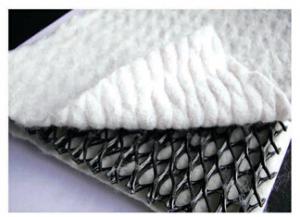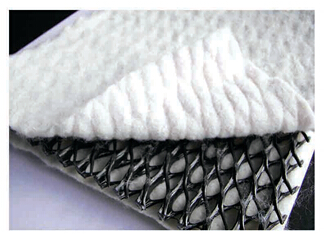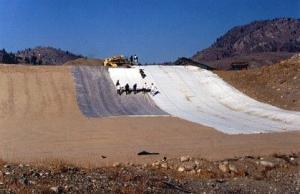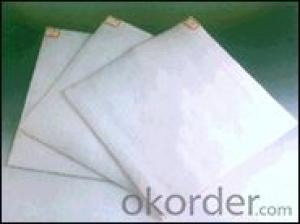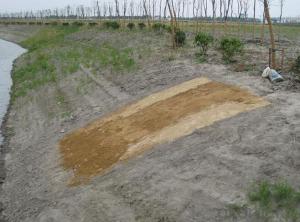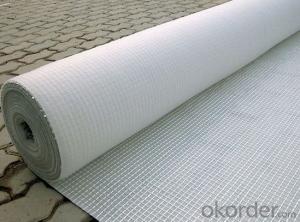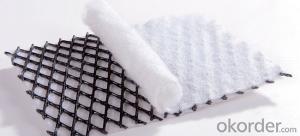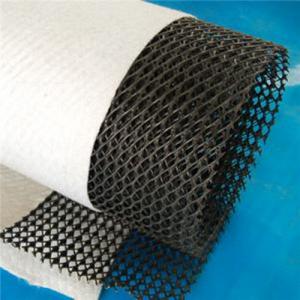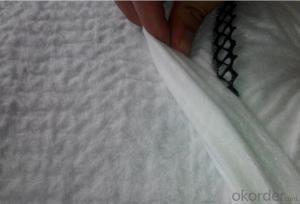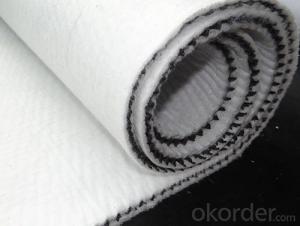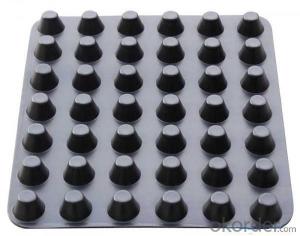Geotextile Filtration Fabric Tri-Dimensional Composite Geonet for Drainage in Road, Railway, Highway, and Tunnel Applications
- Loading Port:
- Tianjin
- Payment Terms:
- TT OR LC
- Min Order Qty:
- -
- Supply Capability:
- 5000rolls m²/month
OKorder Service Pledge
OKorder Financial Service
You Might Also Like
Tri-Dimension Composite Geonet for Drainage 1 for Road Railway Highway Tunnel
It is made of HDPE polymer by extruding into a tri-dimension structure net. Net shape.
Specification of Tri-Dimension Composite Geonet for Drainage 1 for Road Railway Highway Tunnel
Net thickness: 5mm - 8mm, width: 2m - 4m, length as request.
Property of Tri-Dimension Composite Geonet for Drainage 1 for Road Railway Highway Tunnel
I. High drainage property, can bear long time high pressu re
2. High tensile strength and shear strength
3. Reduce probability of geotextile penetration into net to keep high hydraulic conductivity
Application of Tri-Dimension Composite Geonet for Drainage 1 for Road Railway Highway Tunnel
Drainage in landfill, roadbed and road surface, railway, tunnel, underground, retaining wall back
Garden and playground.
Production standard of Tri-Dimension Composite Geonet for Drainage 1 for Road Railway Highway Tunnel
GB/T19470-2004
- Q: Can geotextiles be used in underground gas storage projects?
- Yes, geotextiles can be used in underground gas storage projects. Geotextiles are often used as a lining material in gas storage projects to provide separation, filtration, and reinforcement. They help to prevent the migration of soil particles, maintain the integrity of the storage structure, and ensure the overall stability of the project.
- Q: Can geotextiles be used in foundations and retaining walls?
- Yes, geotextiles can be used in foundations and retaining walls. Geotextiles are often used as a separation and filtration layer between the soil and the foundation or retaining wall materials. They can enhance the stability and durability of these structures by preventing soil erosion, improving drainage, and reducing the risk of soil contamination.
- Q: 5KN or 50KN
- I answered someone else on this question 1. multiply the 1.5th of the expected value of the geotextile sample by the size of the geometric cloth. 2. If you do not know the expected value, it should have a standard tensile strength range, with the tensile strength multiplied by the cross-sectional area of geotextile (thick by the width) to find the force value. 3. If you do not know, it is recommended to choose 50KN or 100KN equipment. Of course, if you need to test the geotextile was cut into a width that is particularly small, then you can use a small amount of force, but it is recommended if you choose from 5KN and 50KN election 50KN good.
- Q: Geotextile what are the specifications of the ah?
- Geotextile is first divided into short wire geotextile and filament geotextile. Their specifications generally according to the weight to count, small equipment, geotextiles are mostly between 80g-380g, and now some mature domestic enterprises generally can do between 100g-1500g short wire and filament geotextile. How many grams of this can be customized between. It should be noted that the same specifications of the short wire geotextile price than the filament geotextile to 30% cheaper, but the technical strength index than the long geotextile cloth nearly 50%.
- Q: How do geotextiles contribute to soil drainage?
- Geotextiles contribute to soil drainage by providing a permeable layer that allows water to pass through while preventing soil particles from clogging or compacting the drainage system. This helps to improve the overall drainage capacity of the soil by promoting the efficient flow of water, reducing the risk of waterlogging, and enhancing the stability and longevity of the soil structure.
- Q: Geotextile price geotextile how much money a square meter
- Woven geotextile: 1.20-8.50 yuan / square meter filament geotextile: 1.60-9.60 yuan / square meter staple geotextile: 1.20-9.80 yuan / square meters impervious geotextile: 3.60-28.0 yuan / square meter geotextile is A new type of building materials, raw materials are polyester, polypropylene, acrylic, nylon and other polymer polymer synthetic fiber. In accordance with the manufacturing method is divided into: there are two types of geotextile and non-woven geotextile. According to the use of anti-seepage, anti-filter, drainage, isolation, reinforcement, protection, sealing, etc. a variety of functions, based on a variety of factors, the price is not the same
- Q: How do geotextiles improve the performance of foundations?
- Geotextiles improve the performance of foundations by providing reinforcement, filtration, and separation. They help distribute loads more evenly, increase the load-bearing capacity, and reduce settlement. Additionally, geotextiles prevent the mixing of different soil layers, control erosion, and enhance drainage, ultimately increasing the stability and longevity of the foundation.
- Q: Pvc tube outsourcing geotextile, how to count how much geotextile
- Calculate the circumference of the bottom of the pipe by the diameter of the pipe, and the length of the pipe is multiplied by the length of the pipe, which is the area of the geotextile. Huazhi geotechnical materials manufacturers to answer your questions
- Q: How are geotextiles used in landfill construction?
- Geotextiles are used in landfill construction to provide reinforcement, separation, and filtration functions. They are placed between the layers of soil and waste materials to help prevent soil erosion, enhance the stability of the landfill, and prevent the mixing of different soil layers. Additionally, geotextiles act as a filter to allow the passage of water while preventing the migration of fine particles, thus reducing the risk of contamination.
- Q: 400 grams per square meter of non-woven geotextiles how much money
- According to your technical parameters, the specific number of professional geotextile manufacturers to answer, power to discuss!
Send your message to us
Geotextile Filtration Fabric Tri-Dimensional Composite Geonet for Drainage in Road, Railway, Highway, and Tunnel Applications
- Loading Port:
- Tianjin
- Payment Terms:
- TT OR LC
- Min Order Qty:
- -
- Supply Capability:
- 5000rolls m²/month
OKorder Service Pledge
OKorder Financial Service
Similar products
Hot products
Hot Searches
Related keywords
